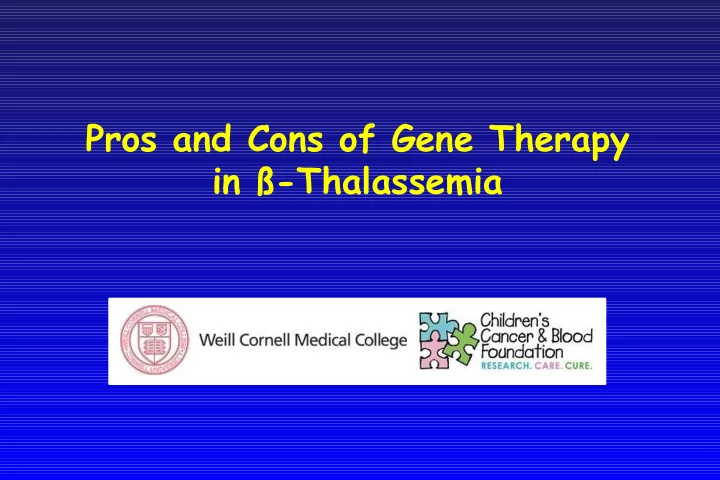

Pros and Cons of Gene Therapy in ß-Thalassemia
ß-Thalassemia: established and potential new ß-Thalassemia: established and potential new therapeutic approaches therapeutic approaches • Many ß-thalassemic patients are treated with blood transfusion and iron chelation. However, the complexity of this disorder and new findings suggest that this conventional approach could be improved upon. • Jak2 inhibitors and hepcidin agonists might soon be utilized to limit ineffective erythropoiesis, EMH, splenomegaly, limit iron absorption and improve the transfusional therapy. • The only definitive cure is bone marrow transplantation. But this approach presents severe limitations such as finding a compatible bone marrow donor and avoiding GVHD. • Gene transfer offers an alternative approach to bone marrow transplant since utilizing autologous hematopoietic stem cells avoids the limitations of finding a compatible donor and prevents GVHD.
Gene therapy of ß-thalasemia Gene therapy of ß-thalasemia Gene transfer using a viral vector (lentiviral vector) • Gene transfer using a viral vector (lentiviral vector) Conditioning of the patient (complete or partial) • Conditioning of the patient (complete or partial) Preclinical and clinical data • Preclinical and clinical data Potential pitfalls • Potential pitfalls Poor chimerism (genetically modified vs. • Poor chimerism (genetically modified vs. untransduced cells) untransduced cells) Genotoxicity • Genotoxicity Potential solutions • Potential solutions
Gene Therapy Schematic Approach Gene Therapy Schematic Approach Hematopoietic Hematopoietic stem cells stem cells Vector carrying the Vector carrying the therapeutic gene therapeutic gene Reinfusion Reinfusion Transduction Transduction
Therapeutic Levels of Hb in Mice Affected by Therapeutic Levels of Hb in Mice Affected by ß-Thalassemia ß-Thalassemia Hb 13-15g/dL Hb 13-15g/dL ß-globin LCR ß-globin LCR 5’LTR 3´LTR 3´LTR 5’LTR TNS9 TNS9 Transfusion Transfusion independent independent Hb 2-4g/dL Hb 2-4g/dL Thal Major Thal Major WT WT Thal Major Thal Major + vector + vector
Correction of Sickle Cell Disease Correction of Sickle Cell Disease
Potential problems Potential problems Poor chimerism Poor chimerism (genetically modified vs. untransduced cells) (genetically modified vs. untransduced cells) The challenge of obtaining therapeutic levels of genetically modified hematopoietic stem cells in beta-thalassemia patients Genotoxicity Genotoxicity The possibility that the chromosomal random integration of the vector can lead to insertional mutagenesis
Chimerism, power of the vector and genotype of the Chimerism, power of the vector and genotype of the patient patient Bone marrow vs peripheral blood chimerism of genetically modified cells Bone marrow vs peripheral blood chimerism of genetically modified cells Bone marrow Bone marrow Selection? Selection? Peripheral blood Peripheral blood It is expected that the selection will be more effective as the vector will be able to express high levels of the beta-globin gene at single copy, irrespective of the chromosomal site of integration
Gene Therapy Clinical Trial for SCID-X1 Halted Due to Insertional Gene Therapy Clinical Trial for SCID-X1 Halted Due to Insertional Mutagenesis Mutagenesis LMO2 gene LMO2 gene ATG ATG + Oncoretroviral Vector Encoding the T and NK cells γ c- + Oncoretroviral Vector Encoding the T and NK cells γ c- Cytokine Receptor Subunit Cytokine Receptor Subunit
Potential solutions: Potential solutions: Insulators Insulators Suicide gene Suicide gene Targeted integration Targeted integration
Ankyrin-ST9W Lentiviral Vector CMV-5’ LTR WPRE ß-globin gene LCR e + ßp HS2 HS3 HS4 AnkST9W 3’ SIN-LTR + Ankyrin Silent mutations sequence They might prevent “genome toxicity” or insertional mutagenesis Insulators are elements thought to reduce expression interference and favor chromatin opening
A Pre-Clinical Approach To establish a simple method to analyze, after gene transfer, a large number of thalassemic erythroid cells derived from patients with different mutations
Transduction of human erythroid precursors isolated from peripheral blood Exapansio In vitro Erythroid Differentiation Exapansio In vitro Erythroid Differentiation (Phase 1) (Phase 1) (Phase 2) (Phase 2) Ficoll separation +/- ß-globin gene Locus Control Region ß-globin gene Locus Control Region p HS2 HS3 HS4 p HS2 HS3 HS4 e + e LTR Ankyrin-sinLTR LTR + Ankyrin-sinLTR RRE RRE SD SA SD SA 840 bp 1308 bp 1069 bp 840 bp 1308 bp 1069 bp 1 Kb 1 Kb
Conclusions Conclusions Gene transfer might offer an alternative approach to bone marrow transplant since utilizing • Gene transfer might offer an alternative approach to bone marrow transplant since utilizing autologous hematopoietic stem cells avoids the limitations of finding a compatible donor and autologous hematopoietic stem cells avoids the limitations of finding a compatible donor and prevents GVHD. prevents GVHD. Preclinical studies in mice are extremely promising. • Preclinical studies in mice are extremely promising. However, some concerns are still present regarding the possibility that these vectors might • However, some concerns are still present regarding the possibility that these vectors might trigger the activity of oncogenes. trigger the activity of oncogenes. It is unclear what is the level of chimerism that need to be achieved. • It is unclear what is the level of chimerism that need to be achieved. Additional preclinical studies using patient cells might be able to address these questions. • Additional preclinical studies using patient cells might be able to address these questions.
Recommend
More recommend